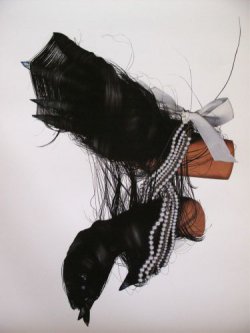E UGENE, Ore. – (Sept. 29, 2009) – For more than a year, the University of Oregon Portland programs have brought students and community members to the university’s newly renovated facility in Old Town Chinatown, near the Burnside Bridge. Now, the UO prepares to open a visual laboratory and classroom in the White Stag Block, with hopes it will continue the move toward a vibrant neighborhood.
UGENE, Ore. – (Sept. 29, 2009) – For more than a year, the University of Oregon Portland programs have brought students and community members to the university’s newly renovated facility in Old Town Chinatown, near the Burnside Bridge. Now, the UO prepares to open a visual laboratory and classroom in the White Stag Block, with hopes it will continue the move toward a vibrant neighborhood.
The new space, called the White Box, will open with a public reception from 5 to 7 p.m. on Thursday, Oct. 8. "Inspiration China," the inaugural exhibition, features pieces by UO digital arts students and alumni who were inspired by ancient Chinese artifacts from the Jordan Schnitzer Museum of Art's (JSMA) extensive Asian collection. The curator of the show is John Jay, co-owner of Studio J and global creative director at Wieden + Kennedy.
"The White Box is a presentation studio, a classroom and a visual laboratory folded into one. It's a multi-purpose educational space that was an important part of our planning at the White Stag Block from the beginning," said Wendy Larson, vice provost of Portland programs. "We are excited to open the White Box, to connect with the creative community and to and invite the public to see our students’ imaginations at work."
The 1,500-square-foot visual laboratory will allow students and faculty to research, explore and present contemporary issues in art and design. The White Box is located at 24 NW First Ave, on the ground floor of the White Stag Block. It will be open from noon to 6 p.m. Tuesdays through Saturdays. Admission is free.
For "Inspiration China," the students created individual art pieces—in various forms of technology and media—that reference and re-interpret Chinese antiquities from selected pieces of the JSMA collection. The new work is presented in a modern context to establish a dialogue between old and new, past and present.
"The students have created contemporary pieces inspired by antiquities of China, giving the ancient objects a new purpose. I wanted to connect students with China to inspire visceral, thoughtful art," said Jay.
In addition to the new student work, 14 pieces from the JSMA Chinese collection will be displayed, including a double-edged sword dating back to 206 B.C., a cinnabar lacquered jar from the 1700s and a 13th to 16th centuries black stone Buddha head.
A bronze, 13 ½-inch-tall incense burner from the 13th to 15th centuries was the inspiration for digital arts graduate student Jesse Sugarmann’s exhibit piece.
"My piece is a three-channel video installation entitled, 'You are the Man now Dog.' It consists of three stacked monitors and stands about six feet tall," said Sugarmann. "In the video, I create an automotive incense burner by channeling the exhaust of eight idling cars into a single pipe. I then stuff that pipe with 1,000 Snuggle-brand dryer sheets in an attempt to mask the toxic odor."
The grand opening exhibit is a collaboration between Studio J, the UO's Department of Art, School of Architecture and Allied Arts, and the Jordan Schnitzer Museum of Art. The students and alumni participating in the show are Elizabeth Bayan, Dominic Cardoso, Alison Ho, Shawna Huang, Andrew Parnell, Zach Rose, MacKenzie Schubert, Rob Smith and Jesse Sugarmann. The exhibit closes on Friday, Nov. 20.
An art tribute to the Naito family's legacy in Historic Old Town will also be unveiled on Friday, Oct. 8. UO digital arts students and faculty have worked closely with Second Story Interactive Studios to create the work. The piece will be displayed in the Skidmore Lobby, near the White box.
In addition, photographs of contemporary and traditional artists and musicians working in China will be displayed on the ground floor of the White Stag Block, 70 NW Couch St. The show, which also opens Oct. 8, is part of ChinaVine.org, an ongoing research project conducted by faculty members at the UO and University of Central Florida. Researchers are Doug Blandy and John Fenn from the UO's Art and Administration program and Kristen Congdon from UCF. Two photos of Shanghai, by Hajo Neis, UO professor of architecture, will also be displayed.
###